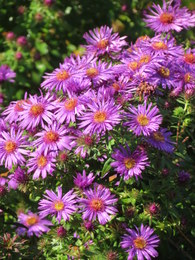Aster Growing Guide
There are about 250 types of asters with some of them being native to North America and Europe. More research was done on the Aster genus (Asteraceae) with most of the species native to North America, Central America and South America being moved into their own genus Symphyotrichum, which now includes about 90-species.
In addition to being deer resistant they are a nectar plant for butterflies and pollinators. They are a beautiful addition to a wildlife garden.
The most common varieties found in garden centers are the New England aster (Symphyotrichum novae-angliae) and the New York aster (Symphyotrichum novi-belgii). Both have bloom times from late summer to early fall.
New England asters (Symphyotrichum novae-angliae) are herbaceous perennials with a native range of eastern to central North America and will do well in USDA Zones 4-8. The flower colors range from red, white, pink, blue and in shades of purple with a typical height of 3 to 5-feet and a spread of 2 to 3-feet.
New York asters (Symphyotrichum novi-belgii) are herbaceous perennials with a native range of eastern North America and will do well in USDA Zones 4-8. The flower colors range from blue, white, and pink and in shades of purple with a typical height of 2 to 4-feet and a spread of 1 to 1.5-feet.
To encourage more blooms and keep them lower you can cut them by half in the early summer.
Starting From Seed
They can be started indoors 6 to 8-weeks before your last expected frost date. From seed many varieties are available, from low mounding to tall. For more guidance our seed starting page will be helpful.
You can direct sow in your flower garden in the late spring to early summer. A large mass planting makes a beautiful display.
There are many annual and perennial varieties available from seed.
Soil Preparation
Plant your aster in full sun to part sun in a nice loose well-drained garden soil and will do best in a slightly acid soil with a pH range of 6.0 to 7.0.
When to Plant
Asters will do best when planted in the spring, but it would be rare to find them in garden centers then. Gardeners expect to buy plants when they are in bloom, which is in the late summer.
In many areas asters will show up in the garden centers in August. Buy your asters as soon as you see them and plant them so that they get good root growth before the ground freezes. Giving them 2 to 3 months of root growth will almost guarantee success.
Planting too late is the most common reason for asters as well as mums to die and not survive the winter.
Planting Asters
Plant them 18 to 24-inches apart or in groups of 3 or 5 behind other shorter plants. Dig a hole as deep as the pot and twice as wide. To the soil you just removed add the same amount of good garden soil so you have a nice blend of new and native soil.
Take the plant out of the pot and gently loosen the root ball pulling away any roots that have grown in a circle around the pot.
Place the root ball in the hole with the growing crown even with or an inch higher than the surrounding soil. Gently spread out the roots and back fill the hole around the root ball leaving a shallow depression around your plant. Fill the depression with water to settle the soil around the roots adding more soil if necessary and water again. Water daily tapering off as the roots grow and get established.
The best planting time is the spring. If purchased from a garden center in late summer they should be planted as soon as you can. To survive the winter they need to get their roots established before the ground freezes.
Watering and Care
They are low maintenance and easy to care for. All you need to do is add a layer of mulch to help retain moisture and keep out competing weeds. They should get an inch of water each week and during dry spells give some water to keep the soil moist. They usually do not need any fertilizer, but a light side dressing of organic fertilizer can be placed around the plant in the spring.
Divide in the early spring every 2 or 3-years just as the new shoots are emerging. Use the divisions to enlarge your flower garden or give to a friend or a neighbor.
Diseases
Powdery mildew, rust, leaf spot are often caused by overcrowding. Increase air circulation around the plants.
Pests
Aphids, nematodes, slugs and snails are occasional problems. For organic gardeners with serious problems, insecticidal soap or neem oil can be used. Always read and follow the instructions on the label.
Popular Varieties
Popular varieties:
New England Aster: Alma Potschke, Barr’s Pink, Harrington’s Pink, Hella Lacy, Honeysong Pink, Purple Dome, Red Star, September Beauty, September Ruby, Treasurer.
New York Aster: Ada Ballard, Bonningale White, Coombe Margaret, Crimson Brocade, Eventide, Henry I, Lady-in-Blue, Marie Ballard, Mount Everest, Patricia Ballard, Royal Ruby, Royal Velvet.
Sources: American Meadows, Stark Bro's Nurseries, White Flower Farm.
Garden Spikes newsletters give you timely information once or twice a month. Subscribe Free to the Garden Times newsletter below.
Your email address will only be used to send you a newsletter and will never be sold. You can unsubscribe at any time.

